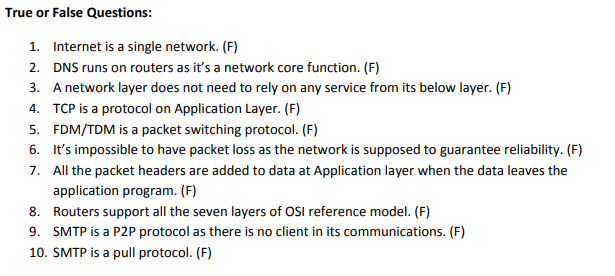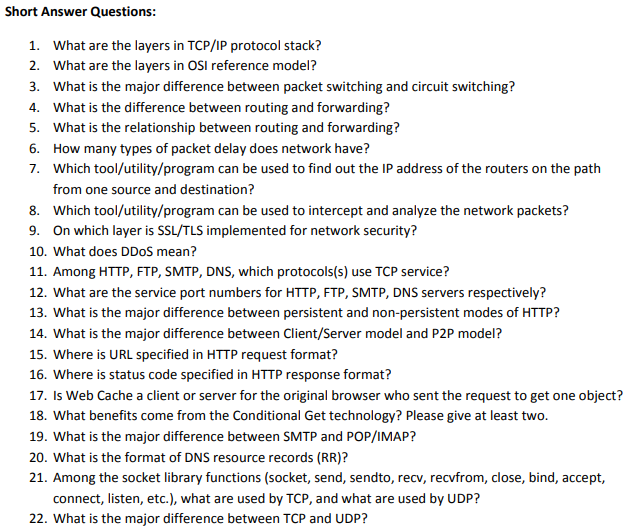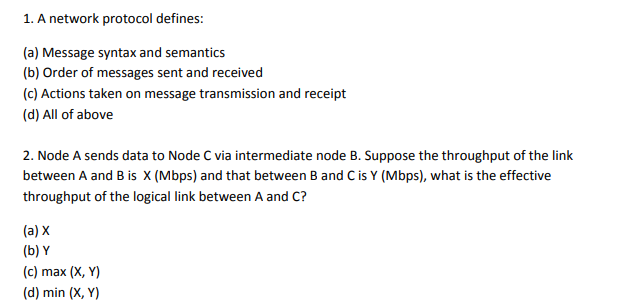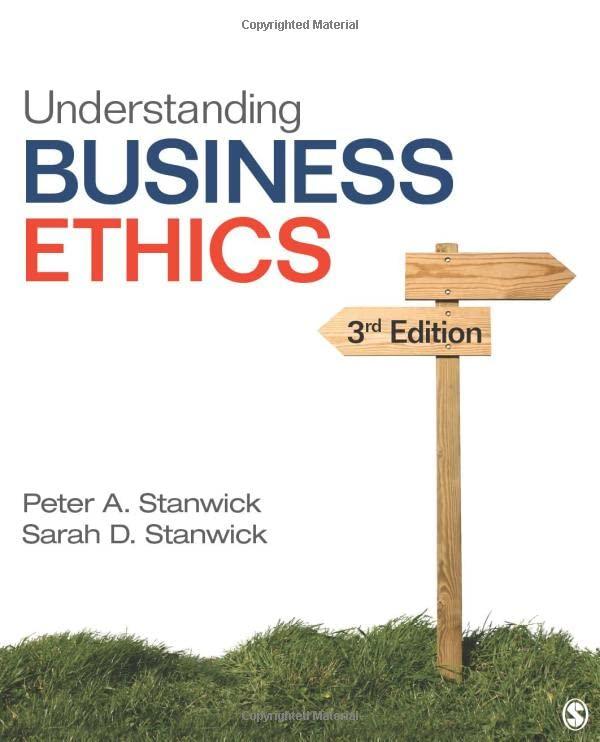Answered step by step
Verified Expert Solution
Question
1 Approved Answer
True or False Questions: 1. Internet is a single network. (F) 2. DNS runs on routers as it's a network core function. (F) 3.



True or False Questions: 1. Internet is a single network. (F) 2. DNS runs on routers as it's a network core function. (F) 3. A network layer does not need to rely on any service from its below layer. (F) 4. TCP is a protocol on Application Layer. (F) 5. FDM/TDM is a packet switching protocol. (F) 6. It's impossible to have packet loss as the network is supposed to guarantee reliability. (F) 7. All the packet headers are added to data at Application layer when the data leaves the application program. (F) 8. Routers support all the seven layers of OSI reference model. (F) 9. SMTP is a P2P protocol as there is no client in its communications. (F) 10. SMTP is a pull protocol. (F) Short Answer Questions: 1. What are the layers in TCP/IP protocol stack? 2. What are the layers in OSI reference model? 3. What is the major difference between packet switching and circuit switching? 4. What is the difference between routing and forwarding? 5. What is the relationship between routing and forwarding? 6. How many types of packet delay does network have? 7. Which tool/utility/program can be used to find out the IP address of the routers on the path from one source and destination? 8. Which tool/utility/program can be used to intercept and analyze the network packets? 9. On which layer is SSL/TLS implemented for network security? 10. What does DDoS mean? 11. Among HTTP, FTP, SMTP, DNS, which protocols(s) use TCP service? 12. What are the service port numbers for HTTP, FTP, SMTP, DNS servers respectively? 13. What is the major difference between persistent and non-persistent modes of HTTP? 14. What is the major difference between Client/Server model and P2P model? 15. Where is URL specified in HTTP request format? 16. Where is status code specified in HTTP response format? 17. Is Web Cache a client or server for the original browser who sent the request to get one object? 18. What benefits come from the Conditional Get technology? Please give at least two. 19. What is the major difference between SMTP and POP/IMAP? 20. What is the format of DNS resource records (RR)? 21. Among the socket library functions (socket, send, sendto, recv, recvfrom, close, bind, accept, connect, listen, etc.), what are used by TCP, and what are used by UDP? 22. What is the major difference between TCP and UDP? 1. A network protocol defines: (a) Message syntax and semantics (b) Order of messages sent and received (c) Actions taken on message transmission and receipt (d) All of above 2. Node A sends data to Node C via intermediate node B. Suppose the throughput of the link between A and B is X (Mbps) and that between B and C is Y (Mbps), what is the effective throughput of the logical link between A and C? (a) x (b) Y (c) max (X, Y) (d) min (X, Y)
Step by Step Solution
There are 3 Steps involved in it
Step: 1

Get Instant Access to Expert-Tailored Solutions
See step-by-step solutions with expert insights and AI powered tools for academic success
Step: 2

Step: 3

Ace Your Homework with AI
Get the answers you need in no time with our AI-driven, step-by-step assistance
Get Started


